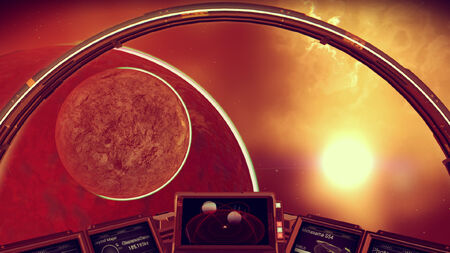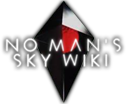
A planet and its Moon seen from space
A planet is a celestial body moving in an elliptical orbit around a star. Players will start on a random planet in a star system near the edge of the Euclid galaxy. When players reach another planet, the planet's basic information (Flora/Fauna presence, Sentinel temperament, biome) will be revealed to the player.
Summary
The universe of No Man's Sky is populated by 18 quintillion procedurally-generated planets of many sizes, colors, and biomes. Each planet orbits a star and rotates around its own axis, creating a cycle of day and night just like Earth. It has not been confirmed, but Sean Murray said that binary systems are probably present in the game.
Some planets are harmless, without worry or danger, but some can be very dangerous to the extent that the planet cannot be explored because of the danger. Initial names of the planets are procedurally generated and can be hard to pronounce, which is not unusual in a sci-fi game. The first player to discover the planet gets one chance to choose to rename it before uploading the information. Planet naming will go through a standard profanity filter.
Planets should be added to the Planets category page as they are discovered and logged.
Influences

Planet surface
- Biome influences the flora, fauna and the general environmental hazard.
- Weather influences the intensity of the environmental hazard and the presence of Exotic elements.
- Sentinel behavior influences how strict they are about the player breaking their rules. If red it means they will even attack on sight, which indicates the presence of natural trade commodities.
Additional Information

When first landing on a planet, the player gains information about the planet on the lower left side. It displays the following information in this order:
- biome + "planet" or "moon"
- weather condition (displayed in red if extreme)
- sentinel behavior (displayed in red if aggressive)
- amount of flora
- amount of fauna
The distance between the planet and the star it orbits is important in defining what kind of biome, atmospheric color, weather, species and even resources the planet may have.
A moon (and sometimes more than one) can be found in orbit around some planets.
Known planets
For a list of known planets, see the Planets category page. For a list of pre-release planets, see the Pre-release planets category page.
(Please use this template while uploading a planet.)
Trivia
Speculation
- It is physically impossible for water to be liquid below -73,15 °C; depending on the pressure it is either solid or gas. Some planets have oceans at this temperature. So, we can assume that not all planets' liquids are made up of water. It is easiest to do this if you forget that the suit voice always refers to liquids as water.



